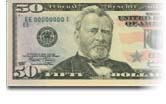In the Money: U.S. Currency Trivia
In celebration of the redesigned currency, SaveWealth.com has compiled a collection of little-known facts about the greenback. For instance, the term "greenback" came from non-interest-bearing notes called Demand Notes, issued by the U.S. in 1861. These notes, with their green backs, were used to finance the Civil War.
SaveWealth has done a little more digging around. Thanks to the U.S. Bureau of Engraving and Printing, here are some other little-known facts:
 Say No to Recall
Say No to RecallEvery piece of U.S. paper currency ever issued since 1861 is valid and legal tender. The U.S. has never devalued or recalled currency.
Biggest Bang for the Buck
The highest value paper currency was the $100,000 Gold Certificate. Issued in 1934, these notes never made it into circulation, but were instead used for transfers between the U.S. Treasury and Federal Reserve banks.
Washington As Popular As Ever
Think the $1 bill is insignificant? Think again. One dollar bills account for 45% of all notes printed, making the $1 bill the most commonly printed.
 Major Case of Writer's Cramp
Major Case of Writer's Cramp In 1861, when the U.S. issued its first major issue of paper currency, each note had to be signed by hand by representatives of the Register of the Treasury of the Treasurer.
Handwritten signatures lasted only one year, when signers complaining of writer's cramp petitioned for new legislation allowing the signatures to be engraved and printed right on the currency.
The Weight of the Bill
Every note, regardless of value, weighs 1 gram. That means 454 bills will equal one pound.
Domestic vs. International
The U.S. dollar is popular around the globe. In the U.S., the $1 and $20 bills are the most common. Around the globe, the $100 bill is the most common.
'Til Death Do Us Print
The U.S. has not changed the historic figures on paper currency since 1929. Should a vacancy open, deceased applicants need only apply. U.S. law, passed in 1866, prohibits portraits of any living person on currency.
Men and Women
Martha Washington has the distinction of being the only woman whose portrait has ever graced U.S. currency. Martha made an appearance on $1 Silver Certificates in 1886, 1891, and 1896.
Talk About Circulation
The government prints roughly 8 billion notes each and every year, enough to stretch around the equator... 30 times.
And Now For Some Perspective
If you could stack 14.5 million dollars, in $1 notes, that pile of currency would reach a mile high.
The projected Federal Budget Deficit for 2005 of $521 billion is enough to build a stack of $1 bills stretching for 35, 931 miles high.
For all things releated to money, check back to SaveWealth.com for the latest news and updates!
Edit: I had a long story here, but deleted. Lets see where others take this, if at all.